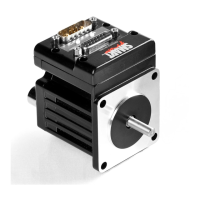Moog Animatics SmartMotor™ Developer's Guide,Rev. L
Page 157 of 909
Should I choose Source Counts or Intermediate Counts?
NOTE: In order to simplify programming and math calculations, it is strongly
recommended that all MFA, MFSLEW and MFD second parameters be the same,
either a 0 or a 1.
Refer to the previous figure. The choice of MFA(x,0) vs. MFA(x,1), 'encoder input to TMP' (or
"source counts") versus 'motor output from TMP' (or "intermediate counts") is application-
dependent. You should use whichever represents the values used in your application. In other
words, it should be values that you want to keep the same effect even if MFMUL/MFDIV is
changed.
NOTE: The MFA(x,1) format of the command is based on the output of the TMP
function (intermediate counts); it ISNOTthe motor/shaft total output!
For example:
l
If you know that you need to follow a conveyor (not driven by the SmartMotor) and
accelerate over 1000 counts distance on that conveyor as the input value, then choose
MFA(x,0) for source counts.
l
If you know that you need follow mode, and the output distance of the acceleration
needs to be a certain distance of the conveyor being driven by a SmartMotor, then
choose MFA(x,1) for intermediate counts.
When in cam mode, the output of the TMP function goes into the cam. Therefore, you will
likely want to select MFA(x,1) to ensure the cam input is a known amount for the TMP (i.e.,
you will execute a known portion of the cam regardless of the MFMUL/MFDIV settings). If you
have a cam application and you need values in terms of source counts distances, then some
additional calculations will be needed in the program (based on the examples given). Refer to
the figureSource Counts into Cam versus Intermediate Counts into Cam on page 158.
Should I choose Variable or Fixed cam?
The choice of fixed length segments vs. variable length segments in a cam is another choice
to make.
Generally speaking, fixed-length segments are simpler and allow more overall points because
less storage space is needed. This works well if you have a large amount of uniformly
sampled data points, for example, the output of a CAD drawing.
Variable segment lengths allow for some special applications. You can more carefully craft a
set of data points that exactly coincide with certain events in the cam input. If you have a set
of data points where you want to reach a specific position for a specific distance of the input
(but that doesn’t line up with a regularly-sampled rate), then the variable-length segments
can be used to exactly line up with those input values. This can produce a smoother, and more
predictable, result if spline interpolation is enabled in cam mode.
Further, with variable segments, there is a possibility that certain types of applications could
significantly reduce the number of cam points required. For example, there is a tool in SMI
that can take data points and apply a "data pruning" to reduce the number of cam points
required. However, the tradeoff is that each remaining point requires more storage space but
the overall table possibly uses vastly fewer points. In addition, variable-segment cams make
it easier to have specific linear and spline interpolated moves in a reduced cam table, allowing
sharp corners mixed with smooth curves in a single path.
Part 1: Programming: Should I choose Source Counts or Intermediate Counts?

